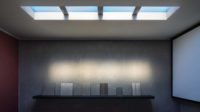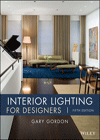Oklahoma City, Oklahoma
Oklahoma City is experiencing a second wind. Having transformed its river from a trickling Army Corps of Engineers drainage ditch into a series of connected lakes that are scullers’ paradises, the Midwestern capital is enjoying an urban renaissance. Now its do-over is moving underground with the reopening of its Conncourse system of pedestrian tunnels, reimagined as a sequence of magnificently saturated zones of color by Elliott + Associates Architects.
The Conncourse—originally named for a local banker, Jack Conn, who helped conceive the system in the early 1970s—has been redubbed the Underground. Construction of the network actually dates to 1931, when William Skirvin won city approval to build a subterranean connection between his eponymous hotel and office towers, but it was Conn who convinced the city to expand the link into a whole network with just over a mile of tunnels. Wind originally drove the city underground. “If you spend any time on the streets of Oklahoma City, your tie stands straight out. It’s blowing 30 miles an hour, constantly,” explains architect Rand Elliott, FAIA.
The Conncourse never featured the shops and services found in other enclosed urban walkways, such as the underground system of Montreal or Minneapolis’s Skywalks, since it is a 12-by-8-foot conduit used almost exclusively for pedestrian circulation. But many city residents faulted the tunnels for removing people, their business, and dynamism from the streets and downtown in general. In reality, the Conncourse, dank and improperly maintained, turned off potential users, and received less and less attention over the years. When Downtown Oklahoma City Incorporated (DOCI) issued a request for proposals to renovate 3,700 linear feet of the tunnels in 2002, “many people said we should fill them with concrete,” Elliott notes. Eery mercury-vapor lamps illuminated ripped carpeting patched by duct tape, supergraphics left over from the 1970s, and a jerry-built tangle of electrical wiring.
Elliott says that during DOCI’s architect-selection process, his team did not present a specific vision for revamping the Conncourse. Rather, “I think our passion and excitement came through.” So did the general notion that the tunnels should be better illuminated, “because it was the least expensive thing we could do with the highest amount of impact.” In addition, Elliott and project architect Michael Hoffner, AIA, say they were keenly aware of infrastructural limitations. “It was all poured-in-place concrete, so the electrical outlets and junction boxes literally were in fixed positions. Talking with residents, we had heard that the Conncourse was scary; it was dark; it was damp. All the creature comforts were missing. The challenge was taking the existing conditions and making something exciting out of them.”
While collecting people’s impressions of the Conncourse, the architects learned from security guards that users would get lost frequently. So they determined to use color as a navigational tool. “The color of each section represents the particular function of the downtown area above it,” Hoffner explains. Where there are clusters of federal and municipal buildings, the Underground is bathed in American-flag blue and red. Yellow represents the offices of the energy companies overhead, green stands for banking, and fuscia means hospitality.
The design team kept its scheme of “galleries” as simple as possible. It tucked the old network’s haphazard array of wiring into channels fashioned from pre-engineered metal gutters. And to create the project’s memorable atmosphere, it used a common theatrical application: T8s set in polycarbonate sleeves with dyed polyester film bouncing intense color off white walls and ceilings and gray carpeting. It installed the fluorescent tubes in various configurations depending on the positions of electrical outlets.
Although the design of the Underground may look simple, the architects have given users plenty to contemplate. Trios of convex security mirrors, lined vertically, punctuate the galleries. In one hallway, yellow and blue combine along one side so that they overlap and appear white on the opposite wall, about which Elliott says, “There’s a little bit of alchemy here.” Exhibitions of historic photographs also punctuate monotonous stretches. “We want to immerse people in different experiences. Like window shopping in Manhattan, you can find yourself walking six blocks and not realizing it.” For those who may become distracted by the additional programming—or for pedestrians who prefer to navigate by maps and cardinal directions rather than landmarks—the architects distinguished each “portal” between color zones by a panel featuring a map, compass points, and a list of nearby above-ground buildings in minimal DINEngschrift type.
Since its makeover, the Underground has been embraced by a range of people beckoned by the colorful glow creeping up stairwells and reaching the sidewalks. Now exercisers take their daily walks in the tunnels and teachers bring their students to the photography exhibitions. While Elliott says the project encapsulates his firm’s longstanding interest in banal, auxiliary, or interstitial spaces that other architects overlook, he adds that the Underground offers an equally important symbol for Oklahoma City. “We are mis-typecast as poor, dumb Okies, and that’s really not true at all. There’s a great sense of pioneering spirit here, and the Underground represents all that energy coming forth.”





